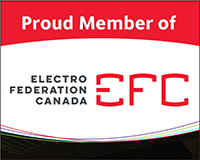CANADIAN PERSPECTIVES CODES AND STANDARDS – STEVE DOUGLAS, QPS SENIOR TECHNICAL CODES SPECIALIST
A history of the Canadian approval process
Reading Time: 7 minutes
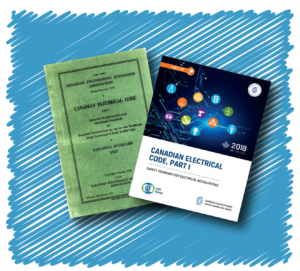
This is a question that electrical inspectors in Canada have been answering since the first edition of the Canadian Electrical Code published in 1927. In the current Canadian Electrical Code Part I (CE Code) Rule 2-024 states:
- 2-024 Use of approved equipment (see Appendices A and B)
- 1) Electrical equipment used in electrical installations within the jurisdiction of the inspection department shall be approved and shall be of a kind or type and rating approved for the specific purpose for which it is to be employed.
- 2) Notwithstanding Subrule 1), equipment described in Rule 16-222 1) a) shall not be required to be approved.
To better understand this requirement, we need to look at the definition for the word “approved”.
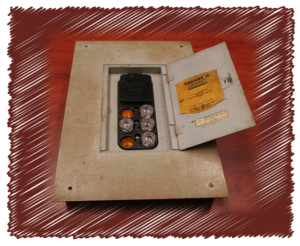
The word “approved” in the Canadian Electrical Code Part I (CE Code) has a different meaning than the same word in the National Electrical Code (NEC). The NEC defines “approved” as: “Acceptable to the authority having jurisdiction.” In the CE Code the word “approved” means much more and is defined as:
Approved (as applied to electrical equipment) —
1) equipment that has been certified by a certification organization accredited by the Standards Council of Canada in accordance with the requirements of
a) CSA Group Standards; or
b) other standards that have been developed by a standards development organization accredited by the Standards Council of Canada, or other recognized documents, where CSA Group Standards do not exist or are not applicable, provided that such other standards or other recognized documents
i) are correlated with provisions of the CE Code, Part I; and
ii) do not create duplication with standards already listed in Appendix A; or
2) equipment that conforms to the requirements of the regulatory authority (see Appendix B).
An electrical product that is approved for use in Canada would be similar to an electrical product that is listed and labeled for use in the USA, except that the NEC does not have an explicit requirement that all electrical equipment installed in accordance with the Code, must be “listed and labeled”.
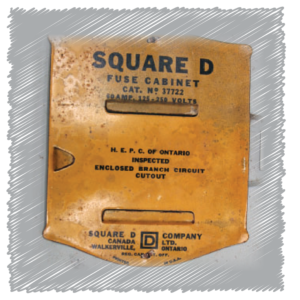
The nameplate for the 60 A 125/250 V Square D fusible distribution panel. Note the approval marking on the nameplate recognized by the Hydro Electric Power Commission and the approval label.
1927
The requirement for approval of electrical equipment in Canada has evolved since 1927 with the definition changing twelve times, and the rule requiring approved electrical equipment changing five time. In the first edition, the definition for the word “approved” read:
Approved: When used with reference to any particular electrical equipment, means that such equipment has been submitted for examination and test to Underwriters’ Laboratories of Chicago, or the Laboratory of the Hydro Electric Power Commission of Ontario, or a recognized Canada Government laboratory, and a formal written report thereon has been obtained, to the effect that such equipment is suitable for sale and use. When used with reference to any type of wiring, form of construction or method of installation it means that it is acceptable to the Inspection Department, and that written notification to that effect has been given.
Note: For the time being, until a Canadian Government Laboratory is established, local governing authorities in the various provinces will decide whether the approval of one or both of the other two laboratories mentioned shall be accepted.
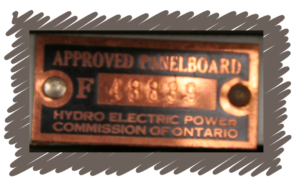
In addition to the nameplate and approval label shown in Photo 2, a permanent copper approval label was affixed to the inside of the panelboard cover.
As you can see; in 1927 Canada did not have a third-party testing and certification laboratory, and a monogram indicating certification was not required.
Rule 2-024 1); the rule requiring approved electrical equipment from the 2018 CE Code states:
2-024 Use of approved equipment (see Appendices A and B)
1) Electrical equipment used in electrical installations within the jurisdiction of the inspection department shall be approved and shall be of a kind approved for the specific purpose for which it is to be employed.
This rule started off as Rule 205 (a) in the first edition of the Canadian Electrical Code that read:
Rule 205 (a)
Any electrical equipment to be placed on the market for use in electrical installations within the jurisdiction of the inspection department shall be approved and shall be of a kind approved for the specific purpose for which it is employed.
1930
As you can see, the wording from the first edition to the current code is very similar with editorial changes and the addition of “or type and rating”. In the second edition of the Canadian Electrical Code published in 1930 Rule 205 (a) was moved to Rule 203 (a), and a new Clause (b) was added that read:
(b) The maker’s name, trade-mark or other symbol of identification shall be placed on electrical equipment together with other such markings giving voltage, current, wattage and other appropriate ratings as are prescribed by the Laboratories recognized in this Code. (See definition of the word “Approved”).
By 1953 this product requirement from Clause (b) would be moved to a new Rule 2-028 Marking of Equipment (now Rule 2-100).
1935
In the third edition published in 1935, the acceptable laboratories was changed to the Laboratory of the Hydro Electric Power Commission of Ontario, the Laboratory of the National Research Council, or to the Underwriters’ Laboratories of Chicago.
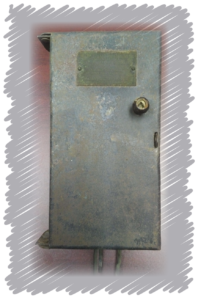
A Canadian Electric & MFG. 30 A fusible service box originally installed in Ontario prior to 1924.
1939
The forth edition of the Canadian Electrical Code (now known as the CE Code) published in 1939, had seen the biggest change limiting the issuance of approval reports to one organization, C.E.S.A (Canadian Engineering Standards Association). A note was also added recognizing examination and testing by other laboratories, and to introduce a follow-up and label/monogram service. The advantage of the label/monogram and follow-up service was that electrical products could be labelled at the manufacturer’s facility.
1947
In the fifth edition of the CE Code published in 1947 the definition of “Approved” recognized the change from C.E.S.A to CSA (Canadian Standards Association), and the AHJs ability to give preliminary approval. The new definition read:
Approved: When used with reference to any particular electrical equipment, means that such equipment has been submitted for examination and test to the CSA and that formal approval has been given to the effect that it conforms to the CSA Standards as established under provisions of the Canadian Electrical Code.
The Inspection Department may give preliminary approval (acceptance) in the following cases: –
1. When such equipment has been submitted for examination and test to the CSA and tentative approval only has been given.
2. When such equipment has not been submitted for examination and test because (a) an appropriate specification of the C.E. Code Part II has not yet been published or (b) the Approvals Laboratory does not possess (or have access to) adequate testing facilities to perform the necessary tests.
Note: The CSA to authorise Laboratories to examine and test electrical equipment, and these Laboratories will issue reports to the CSA and approvals based thereon will be issued by CSA. The CSA has instituted a follow-up service (examination or label service). (For information in detail see the CSA Approvals Manual, to be published)
1953
In the sixth edition, published in 1953. the reference to CSA in the definition was changed to CSA Approvals Laboratories, and Rule 203 (a) and (b) was revised and moved to Rule 2-026 that read:
Rule 2-026 Use of Approved Electrical Equipment
Electrical equipment used in electrical installations within the jurisdiction of the inspection department shall be approved and shall be of a kind or type and rating approved for the specific purpose for which it is to be employed.
1958
In the seventh edition published in 1958 a requirement was added mandating that each certification report be adopted by two-thirds of the Inspection Authorities represented on the Approvals Council.
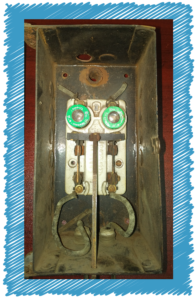
The interior of the Canadian Electric & MFG. 30 A fusible service box installed in Ontario prior to 1924. Note: both lines are fused and there was no provision to ground the system neutral.
Approved, when used with reference to any particular electrical equipment, means that such equipment has been submitted for examination and test to the CSA Testing Laboratories and that formal certification by the CSA Testing Laboratories has been given to the effect that it conforms to the CSA Standards as established under provisions of the Canadian Electrical Code, and the certification report has been adopted by two-thirds of the Inspection Authorities represented on the Approvals Council.
1975
In the twelfth edition of the CE Code published in 1975 in addition to some editorial changes the definition recognizes that the authority enforcing the code can define “approved” separately, and the reference to “the Inspection Authorities represented on the Approvals Council” was replaced with “the Provincial Inspection Authorities represented on the Committee on Part I”
1986
The definition for “approved” remain unchanged in the next two editions. The fifteenth edition published in 1986 “the Provincial Inspection Authorities represented on the Committee on Part I” was changed to “the Provincial / Territory Inspection Authorities represented on the Committee on CE Code Part I” This now recognizes the three Canadian Territories and reference to Part I as CE Code Part I.
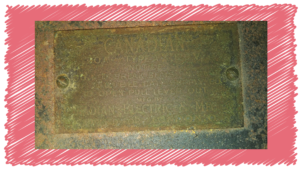
The nameplate Canadian Electric & MFG. fusible service box. Note: the service box is rated 120 V. Fusing the identified conductor (neutral) and not grounding the system at the service box was allowed in Ontario prior to 1924.
2002
The next three editions remained unchanged until a complete rewrite of the definition of “approved” in the nineteenth edition published in 2002 that read:
Approved as applied to electrical equipment means that
(a) A certification organization accredited by the Standards Council of Canada in accordance has certified such equipment in accordance with the requirements of
(i) CSA Group Standards; or
(ii) Other recognized documents, where such CSA standards do not exist or are not applicable; or
(b)Such equipment conforms to the requirements of the regulatory authority;
Introduction of the Standards Council of Canada document CAN P-3 detailing the process used to certify electrical equipment, allowed the requirement for certification reports to be adopted by two-thirds of the Inspection Authorities to be removed from the definition of approved.
2006
In the twentieth edition published in 2006 the only change to Rule 2-024 was the addition of the reference in the title to Appendix A Safety standards for electrical equipment, Canadian Electrical Code, Part II. This is a significant change as the CE Code now has a list of acceptable electrical product standards.
2012
The 2009 edition remained unchanged. In the Twenty-second edition published in 2012 an Appendix B note was added for the definition of approved that read:
Appendix B
Approved
It is intended by this definition that electrical equipment installed under provisions of this Code is required to be certified to the applicable CSA product Standards as listed in Appendix A. Where such CSA Standards do not exist or are not applicable, it is intended by this definition that such electrical equipment be certified to other applicable Standards, such as ULC standards. Code users should be aware that fire alarm system equipment is deemed to be approved when it is certified to the applicable product Standards listed in CAN/ULC S524.
This definition is also intended to reflect the fact that equipment approval could be accomplished via a field evaluation procedure in conformance with the CSA Model Code SPE-1000, where special inspection bodies are recognized by participating provincial and territorial authorities having jurisdiction. For new products that are not available at the time this Code is adopted, the authority having jurisdiction may permit the use of products that comply with the requirements set out by that jurisdiction.
This appendix note helped clarify the use of safety standards for fire alarm systems in Canada, developed by the ULC (and listed in ULC S524 – standard for installation of fire alarm systems). and use of the SPE-1000 Model Code for the field evaluation of electrical equipment.
2015
In addition to ULC, other standards development organizations were first recognized in the definition of the word “approved” in the Twenty-third edition of the CE Code, published in 2015 on the conditions that these standards by other Standards Development Organizations:
(a) are not duplicating the existing CSA safety standards; and
(b) are correlated with provisions of the CE Code, Part I.
In addition to these changes, the definition “approved” was expanded to include equipment that conforms to the requirements of the regulatory authority. Rule 2-024 was also changed adding an Appendix B note and a new Subrule 2) that recognizes the exception allowing use of equipment without being “approved” for connection to a Class 2 circuit in accordance with Rule 16-222(1)(a). It should be noted, that Rule 16-222 requires lighting products, electromedical equipment, equipment for hazardous locations, and thermostats incorporating heat anticipators to be “approved”.
The new Appendix B note for Rule 2-024 directs code user to the definition for the word “approved”.
The note also advises code users that modification of originally approved electrical equipment may void that original approval. An exception to this is the use of an approved field installable kit. An example of an approved field installable kit (that would not void the original approval) would be a neutral block that could be added to a fusible switch if the neutral block modification kit was part of the certification for the fusible switch. Modifications to approved equipment that has been voided by not using approved field installable kit – would require field evaluation in accordance with the SPE-1000 Model Code for the field evaluation of electrical equipment.
2018
The wording for the definition of “approved” and Rule 2-024 including the Appendix B notes remained unchanged in the Twenty-forth edition publish in in 2018 that reads:
Approved (as applied to electrical equipment) —
1) equipment that has been certified by a certification organization accredited by the Standards Council of Canada in accordance with the requirements of
a) CSA Group Standards; or
b) other standards that have been developed by a standards development organization accredited by the Standards Council of Canada, or other recognized documents, where CSA Group Standards do not exist or are not applicable, provided that such other standards or other recognized documents
i) are correlated with provisions of the CE Code, Part I; and
ii) do not create duplication with standards already listed in Appendix A; or
2) equipment that conforms to the requirements of the regulatory authority (see Appendix B).
Approved
It is intended by this definition that electrical equipment installed under provisions of this Code is required to be certified to the applicable CSA product Standards as listed in Appendix A. Where such CSA Standards do not exist or are not applicable, it is intended by this definition that such electrical equipment be certified to other applicable Standards, such as ULC Standards. Code users should be aware that fire alarm system equipment is deemed to be approved when it is certified to the applicable product Standards listed in CAN/ULC-S524.
This definition is also intended to reflect the fact that equipment approval could be accomplished via a field evaluation procedure in conformance with CSA Model Code SPE-1000, where special inspection bodies are recognized by participating provincial and territorial authorities having jurisdiction. For new products that are not available at the time this Code is adopted, the authority having jurisdiction may permit the use of products that comply with the requirements set out by that jurisdiction.
2-024 Use of approved equipment (see Appendices A and B)
1) Electrical equipment used in electrical installations within the jurisdiction of the inspection department shall be approved and shall be of a kind or type and rating approved for the specific purpose for which it is to be employed.
2) Notwithstanding Subrule 1), equipment described in Rule 16-222 1) a) shall not be required to be approved.
The 2018 CE code also has a change in Appendix C Clause C11.15 that covers CE Code formatting and rule terminology requirements when developing rules for the CE Code. Clause C11.15 limits the use of the word “approved” in the body (rules) of the code to Section 0 for the definition and in Rule 2-024. Usage like the term “specifically approved for the purpose” have been removed from most sections of the code with the remaining section schedule to be completed by the 2021 publication. Where a clarification is required to detail specific approvals. This must now be only done in an Appendix B note. An example of this is the requirement pendant ceiling fan boxes in Rule 12-3000 8). that requires outlet box marked for fan support to be used. The word “approved” was removed from Subrule 8) as a duplication of the requirement for all equipment to be approved in Rule 2-024. In addition, an Appendix B note explains the specific approval requirements and the Standard used for certification of the fan support boxes.
Another significant change in the 2018 CE Code is the subdivision of Appendix A into Annex A1 and Annex A2
Annex A.1 includes a list of acceptable CSA (Canadian Electrical Code, Part II) safety standards for electrical equipment, and Annex A.2 has a list of other acceptable Canadian safety standards (standards developed by other Standard Development Organizations) for electrical equipment.
about the author
 Steve Douglas is an IAEI International Past President. He is also the Senior Technical Codes Specialist for QPS Evaluation Services. As the International Association of Electrical Inspectors Representative on Part I and Part II of the Canadian Electrical Code, Steve is the Immediate Past Vice Chair of the CE Code Part I, Chair of CE Code Part I Subcommittees for Section 2, and 12, and a member on Sections 8, 40, 64, 68, 76 and Appendix A. In addition Steve is the Chair of the Subcommittees for the CSA Standards C22.2 No. 273 Cablebus, C22.2 No. 327 HDPE Conduit, C22.6 No. 1, Electrical Inspection Code for Existing Residential Occupancies committee, SPE-1000 Subcommittee, the Chair of the Technical Committee on Wind Turbines, and a member on committees for the Objective Based Industrial Electrical Code, Safety Management Systems, Solar Photovoltaic Modules, Industrial control panels and assemblies, Photovoltaic Cable, Fuel Cells, Wind Turbines, Distribution transformers, Outlet Boxes, and Wiring Fittings Hardware and Positioning Devices.
Steve Douglas is an IAEI International Past President. He is also the Senior Technical Codes Specialist for QPS Evaluation Services. As the International Association of Electrical Inspectors Representative on Part I and Part II of the Canadian Electrical Code, Steve is the Immediate Past Vice Chair of the CE Code Part I, Chair of CE Code Part I Subcommittees for Section 2, and 12, and a member on Sections 8, 40, 64, 68, 76 and Appendix A. In addition Steve is the Chair of the Subcommittees for the CSA Standards C22.2 No. 273 Cablebus, C22.2 No. 327 HDPE Conduit, C22.6 No. 1, Electrical Inspection Code for Existing Residential Occupancies committee, SPE-1000 Subcommittee, the Chair of the Technical Committee on Wind Turbines, and a member on committees for the Objective Based Industrial Electrical Code, Safety Management Systems, Solar Photovoltaic Modules, Industrial control panels and assemblies, Photovoltaic Cable, Fuel Cells, Wind Turbines, Distribution transformers, Outlet Boxes, and Wiring Fittings Hardware and Positioning Devices.



